| THE BIG DOCK AND T-DOCK
|
| AT |
|
RODGER'S BEACH ON THE BIG
LAGOON
|
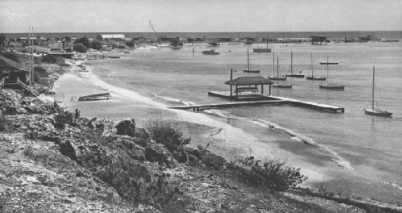 |
| The T-Dock with Snipe sail boats. Note
one Snipe is under cover having its bottom calked and painted and one is on the
beach. The construction of the New Esso Club can be seen in the back of
the photo where the crane boon is sticking up. |
| Earlier photos of the T-Dock supplied by
Stan Norcom. |
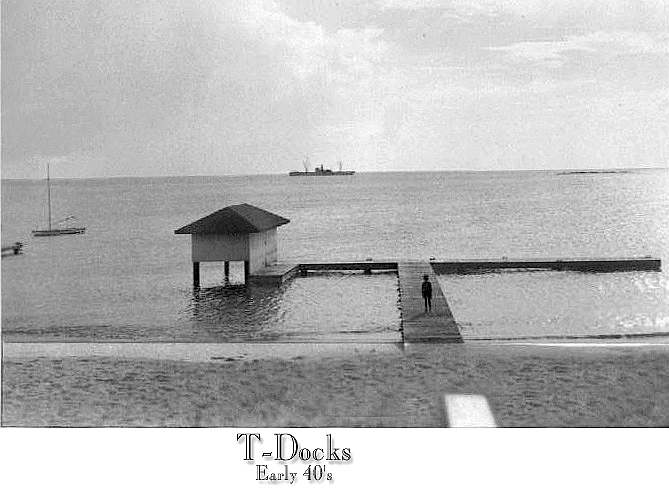 |
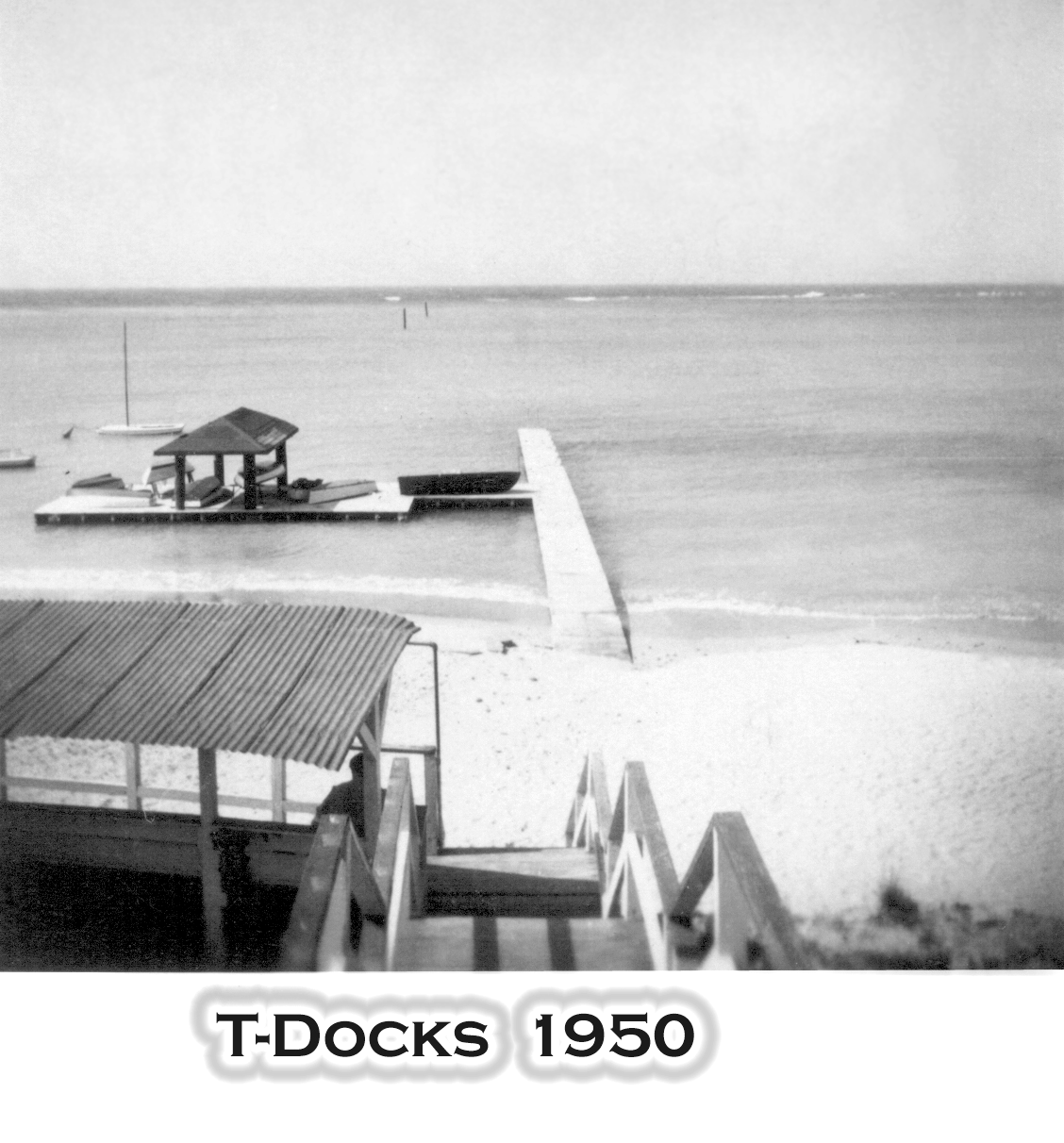 |
|
This photo was taken from the T-Dock looking towards
the lower road. The sewer pipe we all walked to get from one location to
the other, it sure beat walking on the coral. Bungalow 69, the Mingus'
house can be seen on the top left. |
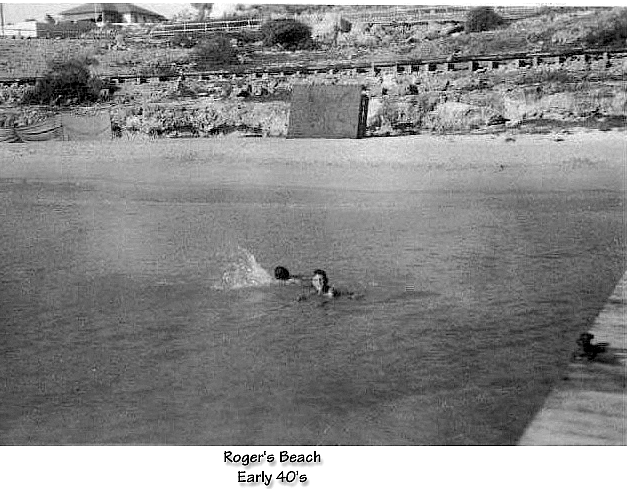 |
| The following color photographs are supplied by Homer Waits |
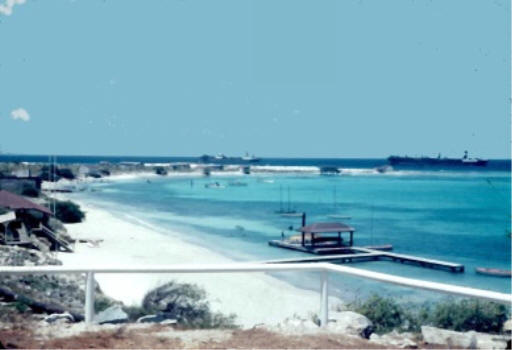 |
| Above, a view of the T-Dock, note the loaded tankers just off the coast, leaving Aruba
with a load of product. There is no New Esso Club in this
photo and some of the party houses further up the beach can bee seen as well as
the green house on piles. |
| And yet another view of a
re-configured dock, but it was still called the T-Dock, this photo provided by
Karen Keefer-Johnson. Click on photo below to go to a larger view. |
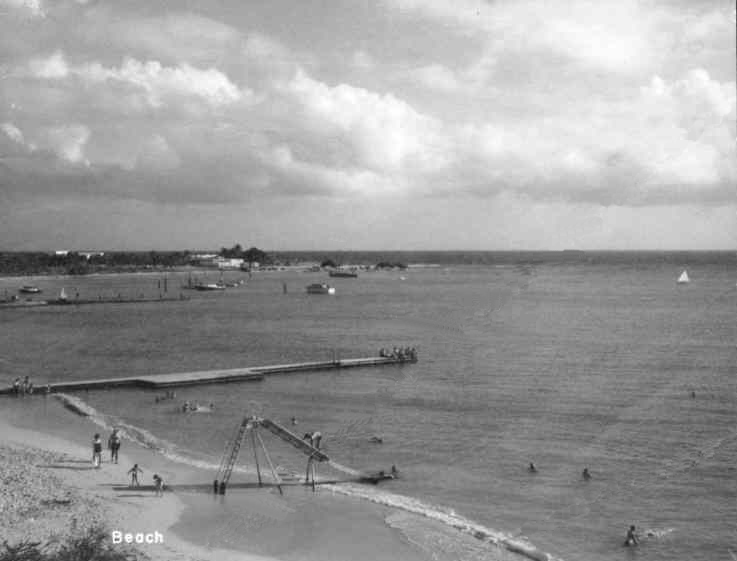 |
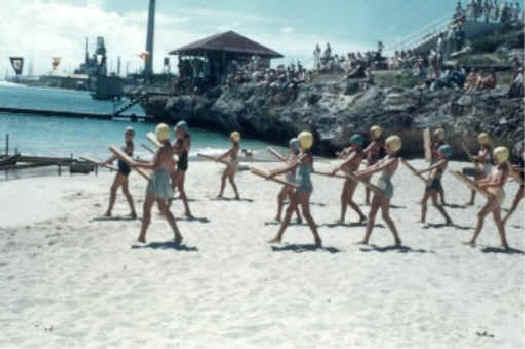 |
|
Girls getting ready to enter the water as part of
a water show. The changing facility for the Big Dock is seen in the center
of the photo and the refinery with the Cat Cracker is in the back ground.
Note the number of persons sitting on the coral to watch the show. You can
see that construction has just started on the slide.
|
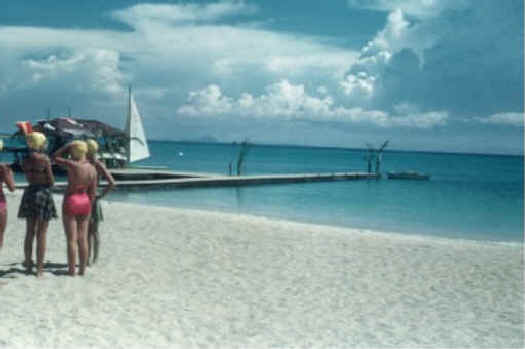 |
|
T-Dock and Rodger's Beach with the sugar, white
sand and crystal clear
water of the Big Lagoon
|
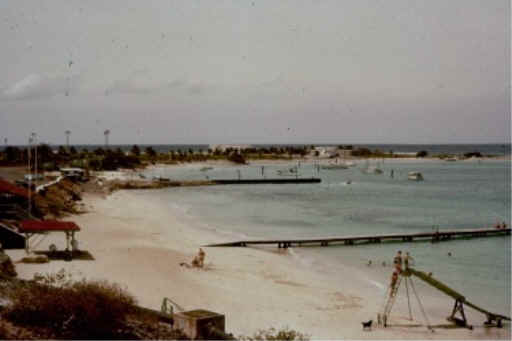 |
| A later photo of the T-Dock the Boat Dock and Rodgers
Beach. Note the configuration of the dock has been changed, the covered
shed was removed and the dock is now straight but it was still called the
T-Dock. A slide was added and another dock, the Boat Dock, was also added. |
.jpg) |
|
A favorite place to congregate on
the weekends was the Big Dock, some swam and some just "hung out" at the bottom
of the Big Dock steps
|
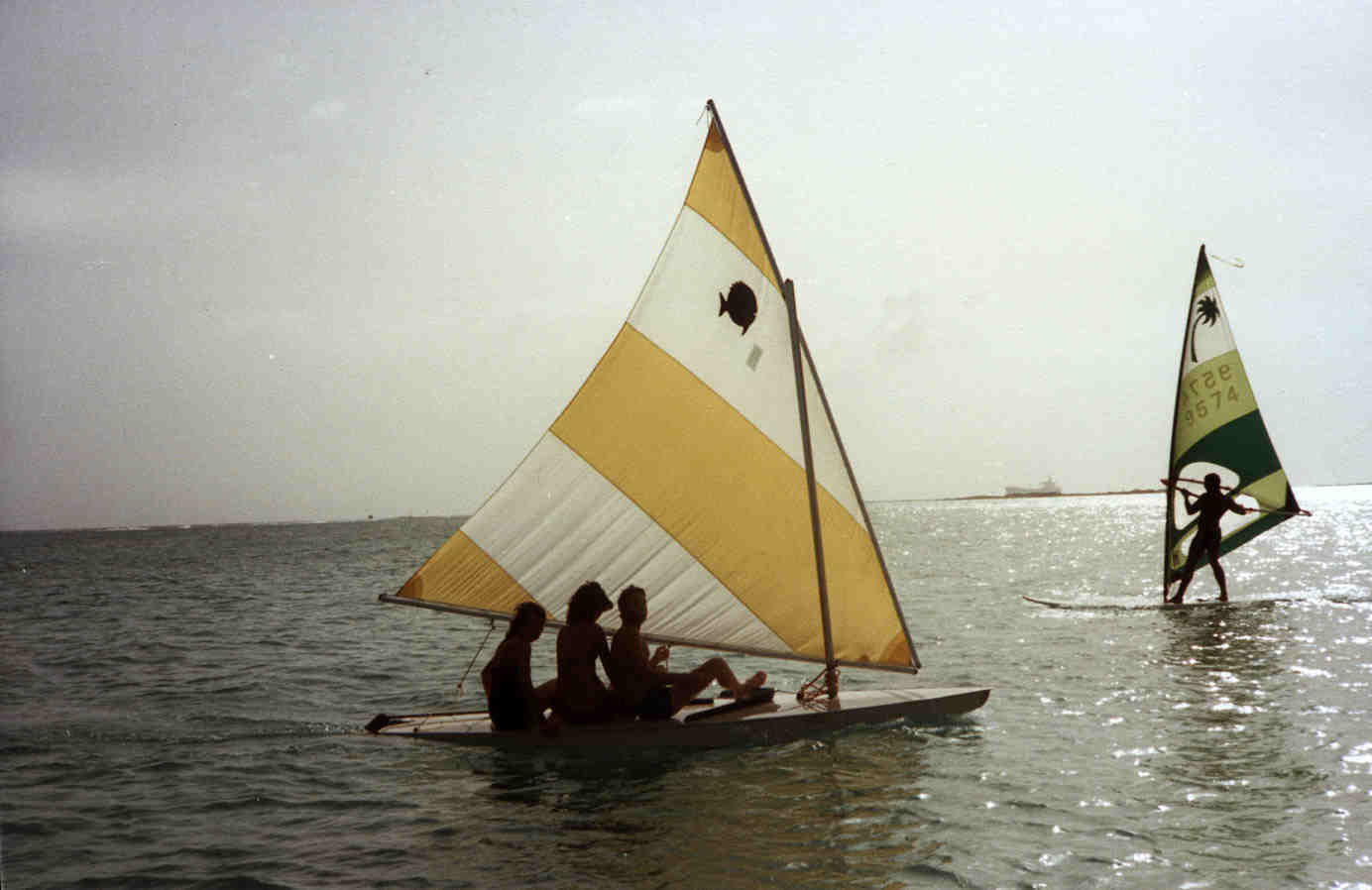 |
|
Sailing off Rogers Beach in the Big Lagoon in
the 80's. Photo provided by
Yvonne van der Putten-Brinkman.
|
|
BABY BEACH – T-DOCK – BIG DOCK |
|
AND THE GAME OF |
|
MATCH |
| By:
Dan Jensen |
|
If you grew up on Aruba, and it
was the weekend, you were probably at the beach.
Your age dictated at which beach.
|
| Beach life in Aruba began at
Little Lagoon, now called Baby Beach. Mothers
took their young babies there to lean to swim.
It was calm. The protected,
warm, crystal clear, shallow water, over a white sand bottom, was ideal for
teaching young children and babies to swim. |
|
Baby Beach has changed from what I knew as a child.
When I was young, there was a small mangrove tree to the East of Baby
Lagoon. I remember climbing inside
the mangrove tree and climbing around on its branches and roots that grew above
the water. There were open spaces
cut in the tree, with channels out to the shallow lagoon.
These were the places fishermen kept their boats, protected there from
the sun and out of view from anyone who may decide to use the boat.
The shallow water under the tree and in the lagoon in front of the tree
flowed from a break in the reef to the East of the tree, into Baby Lagoon.
This river of water formed an island of pink sand next to the reef. We called it Pink Island.
Now the mangrove tree and the lagoon by the tree are gone, as is the flow
of water. The beach at Little
Lagoon and Pink Island are one. |
| I learned to swim at Little Lagoon, at the age of two.
My Mother and Lize McDonald took me to the beach every day, first to play
in the sand, then to venture into the little waves, which ran up on the beach.
Later they took me into the ankle deep water to dog paddle and then to
swim. |
| When I was seven or eight I could swim well enough to go
from the beach to Pink Island, via the raft that was anchored in the middle of
the lagoon. Soon after that I
started to go to the Little Lagoon by my self. |
|
As I grew older, I became a better swimmer, and grew tired
of the protected, shallow water of the Little Lagoon. I started swimming at the T-Dock at Rodger’s Beach.
When I was old enough to swim at the T-Dock it was no longer shaped like
a T. The old T-Dock had rotted and
a new straight dock with a platform to the East had replaced it.
Even in the new configuration we still called it the T-Dock.
The platform on the side of the T-Dock had a roof over it and was
intended to be use by boat owners to repair the sailboats, where they would be
protected, out of the sun. We used
the roof as a diving and jumping platform; if we went off the roof towards the
beach we jumped because the water was too shallow to dive. If we went off the other side of the roof, we dove, as the
water was about eight feet deep. |
|
Four hundred yards to the west of the T-Dock and parallel to the T-Dock
was the Big Dock. You could reach
the Big Dock in one of four ways. Swim.
Walk the path over the coral from the yacht club to the Big Dock changing room,
Walk the sewer pipe, or you could go up the steps at the T-Dock, walk down the
Lower Road and then go back down the steps to the Big Dock. Everyone
seemed to wake the pipe or take the path or swim. |
|
There was no beach at the Big Dock, only coral cliffs.
From the changing room you went down steps to the dock and out to the
diving platform at the end of the dock. There
was a diving board at the dock level. The diving tower had two platforms. One at about nine feet above the dock, which did not have a
diving board and the top tower, that was about eighteen feet above the dock. The top platform had a diving board and there was a large rope with a
large knot on the end hanging from the outer end of this diving board. The rope was long enough so you could sit on the knot
standing on the dock and then swig out over the water and jump off the end of
the rope. This was a lot of fun but
not as much fun as playing MATCH. There was also a diving board on the
dock. |
|
MATCH was played from the second platform.
The only equipment you needed to play MATCH was a wooden match.
|
|
Someone would start the game by taking the match and diving off the
second platform, then release the Match while they were under the water.
This was the start of the game and that point that person is out of the game. |
| The rest of the players, and sometimes there were twenty or more kids
playing MATCH, stood on the second platform eyes peering at the water and waiting for the match to float to
the surface. The water was so clear
you could see the match before it reached the surface.
Who ever saw the match first jumped into the water and tried to get the match.
However, usually five or six kids saw the match at the same time, so five
or six kids all
jumped in at once. This mass of bodies
hitting the water at one time washed the match away and then the second wave of
kids, still on the second platform, caught site of the match and they all jumped in
after the match.
With half the group in the water and the other half jumping on top of
them, it is a wonder no one was hurt. |
| The water here was about fifteen feet deep and everyone was trying to get as
for out of the water as possible, so they could see the match.
There were no rules as to how you managed to get the match, it was a free-for-all, everyone
pushed the others under the water, shoved others out of the way. Everyone
was trying to drown everyone else, that was the game, getting the match, no
matter what it took, and it was everyone for them self as each individual fought
to retrieve the match. |
| When the match was retrieved, the person who found the match climbed up on the
dock and announced to all those who were still fighting in the water that he had the match. Then
we all came out of the water, half drowned but no hard feeling, back up on the platform and the person who got the
match had the pleasure of diving in and releasing the match to start the next
game. There we would go again, jumping on others, pushing them under and
trying to get the match. |
|
On the weekends, the only game
we played was MATCH, and we played MATCH all day long. |
|
|









.jpg)
